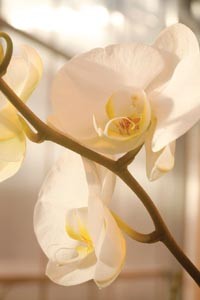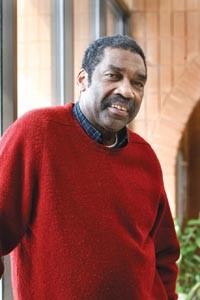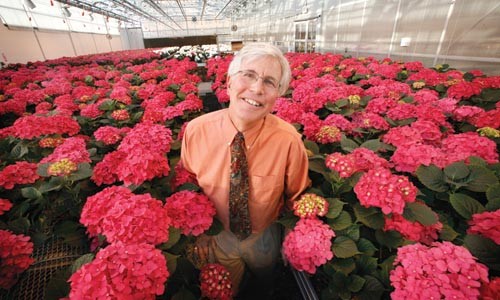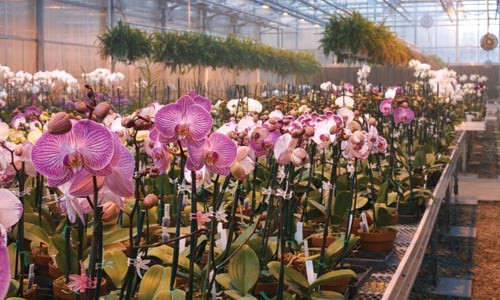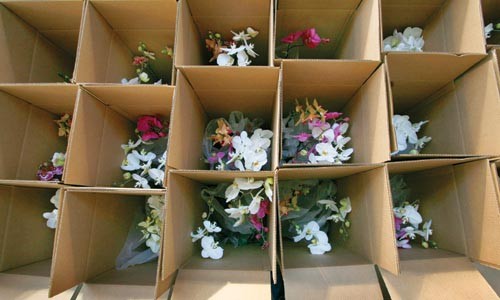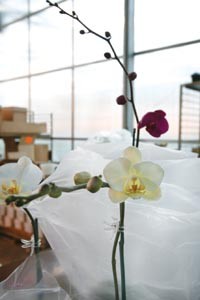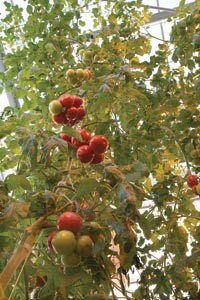You wouldn't expect to find Eden tucked away behind a UPS facility in Manchester. On a chilly January day painted over with Pittsburgh Gray, there isn't much to inspire warmth at the Drew Mathieson Center's acre-sized lot. If you didn't already know the center's greenhouse was housed in its strip-mall-like location amidst the grit of the city's North Side, it would be easy to overlook.
And when you pass through them, the front doors seem like any other secure office building: You need a code to enter the lobby, where a receptionist sits behind a desk. But past her, and past a whiteboard with watering schedules and other notes, suddenly you've entered a green -- and blue, and purple, and red -- wonderland.
Inside, there's a summery smell of tomato vines, still invigorating even if it lacks the intensity of a sun-drenched garden in July. And huge, primordial tomato vines -- up to 60 feet long -- snake toward the ceiling, looping back on themselves, with only small buckets keyed to nutrient lines connecting them to the earth. Bunches of glossy, plump green tomatoes hang teasingly from the vines.
No matter the weather outside, the greenhouse is always bursting with life: vegetables, ornamental plants -- and the training center's signature flower, the phalaenopsis orchid.
There are more than 20,000 orchid species, with hundreds more being discovered each year, but phalaenopsis, the "moth orchid," is one of the most recognizable: Its big, long-lasting blooms float, mothlike, around the spikes. It's probably the orchid most commonly kept as a houseplant.
One sits, in full bloom, on the desk of Bill Strickland, CEO of the Manchester Bidwell Corporation, which administers the Bidwell Training Center, the vocational program that uses the greenhouse.
"A guy brought an orchid to my house," Strickland says. "I said, 'What the hell is that?' I fell in love with them." He now grows the flowers at home, and they are apt symbols of what Bidwell hopes to achieve, bringing beauty and hope where none is expected.
For four decades, the nonprofit has offered vocational training in a variety of fields: health administration, culinary arts, office work -- and horticulture. The programs are free to adults with a high school diploma or GED who pass a competency exam. Often, the most immediate goal is to help people find work. But the programs can also put students -- many of whom are struggling desperately to make ends meet -- in contact with the kind of beauty often reserved for the well-to-do.
Orchids have a mystique all their own -- Susan Orlean's book The Orchid Thief, and the movie inspired by it, Adaptation, chronicle the madness of seekers of rare orchid species. Wealthy devotees once paid adventurers to travel the world in search of new species, and even today, a single orchid can cost thousands of dollars. For more than half a century, the Orchid Society of Western Pennsylvania has lured high-society types and passionate gardeners alike to annual shows and auctions.
But as Strickland puts it, "Whoever said orchids had to be for rich people?"
Beauty has never been just a luxury for Strickland. He credits it with saving him from a life that could have been wasted on the streets. And much of the work he has done in Pittsburgh, he says, he did "as an alternative to shooting people."
A native of the Manchester neighborhood, Strickland says that as a teen he was aimless, doing basically nothing until an art teacher took an interest in him: "My art teacher saved my life. He said, 'You're too smart to die.' He forced me to apply to Pitt." He did, and from there, Strickland went on to dizzying academic heights. He graduated cum laude with a degree in American history and foreign relations. In 1996, he received the MacArthur "Genius" grant for leadership and integrity in the arts, and did a stint guest-lecturing at Harvard Business School. But the jet-setting Strickland remained a Manchester son at heart, and returned to Pittsburgh to launch the Manchester Craftsmen's Guild, a music space and arts incubator.
"I was born in this neighborhood, I'll die here," he says. "I'll just finish up here and they can put me in a hole up on Marshall Avenue."
Strickland took over Bidwell -- then a tiny, struggling program -- 40 years ago, just after starting the guild with seed money from the Episcopal Church. The programs have been housed in a state-of-the-art campus since 1987; the greenhouse was added in 2003. Strickland has helped found similar centers in San Francisco, Cincinnati and Grand Rapids, Mich., with more afoot in Limerick, Ireland; Halifax, Nova Scotia; and Israel. He wants 200 more around the world.
In a way, the facilities Strickland set out to create are hothouses too ... often providing a warmer environment than participants can find in the world outside.
As a participant in the Craftsmen's Guild, for example, "I was nurtured and provided with resources and encouragement -- it was natural that I succeeded," says Sharif Bey, an assistant professor of art education at Winston Salem State University. "Being in an environment where all those possibilities are available, the idea of loafing on the corner was ... stagnant, boring."
Bey grew up in Pittsburgh and, as a teen, fine-tuned his artistic calling at MCG. It was an escape for him, he says, from wasting time sitting in front of the television, and a way to avoid his father's fate, working 10 hours a day at a job he hated. His father, like most men in his family, worked long shifts as a boilermaker, coming home covered in asbestos and falling into bed. By contrast, Bey says by phone from North Carolina, "When I [began at the MCG] in 1988 or '87, I was literally surrounded by billions of possibilities. It was completely natural to be successful in such an environment.
"I think the Craftsmen's Guild is an amazing thing, but it's not really that complex," he adds. MCG provided art materials, of course, but Bey was a smart, artistic kid and had been exposed to that before. What he hadn't experienced was its culture of mentoring and expecting excellence, which lifted him from the mediocrity he might have been expected to aspire to.
"That's the whole point of the center, man," says Strickland. "You can have a beautiful center in your neighborhood. This is normal, not abnormal. You can have a beautiful center in your neighborhood."
You can also have an oasis.
Inside the Bidwell greenhouse are six distinct temperature and humidity zones -- each replicating a different climate for various species to thrive in at various stages in the growth cycle. It's all controlled by a sophisticated computer system called Argus, which adjusts light, humidity and heat and doesn't hesitate to robo-call staff cell phones at 3 a.m. if it can't fix a problem by itself. Bright lights go on and off to mimic summer days and nights, but the work of pollination is done naturally -- by docile honeybees. (The hive, brought in months ago, has dwindled to a few bees, but the staff will buy a new hive in the spring.)
The zones, temperatures and lighting are a finely choreographed ballet -- pot a few thousand hydrangeas and move them after they start to bloom, scoot in new spiking orchids. One zone is given over entirely to hydroponics, the practice of growing plants in nutrient-saturated water rather than dirt. Off to one side is a raised tray of microgreens, their impossibly fragile-seeming roots mingling in the tiny stream below them.
Another zone recalls the poppy field in The Wizard of Oz. It's carpeted in hydrangeas, some blooming puffs of white or blue, some still green and young. They're this year's main cash crop -- the money from selling those and the orchids is reinvested into maintaining the greenhouse. Most of the orchids grown at the center will later be sold at Giant Eagle, Whole Foods and commercial retail florists.
But it's Zone 4, the finishing zone, where the stars of the greenhouse live. Hundreds of phalaenopsis are preparing to burst forth into bloom. The spikes, growing toward the sun, recall an army in formation: The deep-green knuckly structures, with the buds that will grow in many different colors and are yet unformed, point inexorably in a single direction, curved in near-identical, sun-seeking parabolas.
And throughout, they are overseen by greenhouse staff and horticulture students, for whom the greenhouse functions as a laboratory.
Students in the six-month program spend about half their time here, potting new sprouts, nurturing orchids from tiny, bare-root seedlings into gorgeous blooming show-stoppers. The rest, they spend in the classroom, book-learning.
On a Thursday in January, nine mostly rapt students, ranging in age from 18 to 62, sit in a warm, modern classroom on the North Side. Scattered among 17 computer terminals arranged along the rows of long bench-like desks, they face a PowerPoint projection screen that instructor Gary Baranowski isn't using.
He's explaining that the main characteristic used to classify plant families is their flowers -- infloration. The flower he wants to discuss is discernable by its spath and spadix, reproductive structures commonly seen on tropical plants. Standing at the whiteboard, he quickly sketches a flower structure that soon becomes familiar -- at least to anyone who has a peace lily at home.
Baranowski is discussing tropical flowers, but one student suggests that orchids aren't really tropical.
"Aren't they?" Baranowski asks. "Where do they grow? Everywhere! Orchids that grow in Costa Rican rain forests? Tropical. Orchids that grow in Southwestern Pennsylvania? Temperate! Orchidae is the largest plant family. They're represented by every climate zone. They're everywhere but Antarctica."
These students are reaching the end of their six-month program, and will begin externships next month. Most will be placed in jobs in the field -- they might work at golf courses, on greenhouses, in landscaping, for florists.
"Our focus has been solidly on the pot of gold at the end of the rainbow -- a career," says Baranowski later.
Baranowski, who speaks with the slight accent of a highly educated lifelong Pittsburgher, and sports a tie printed with tiny pineapples, has a résumé with tendrils that trail all over the city.
He began as a horticulturalist at Phipps Conservatory during a hiring freeze -- he was so persistent after an informational interview that he managed to get hired on in a temporary, federally funded year-long position. He parlayed that into all sorts of jobs over the years, working his way from laborer to executive director of the whole place. He worked at the Pittsburgh Public Schools, consulting at Bidwell before being putting down full-time roots six years ago.
It's that kind of persistence he hopes to inculcate into students, and it seems to be working. Seventy-nine percent of those who graduate from Bidwell's eight programs are placed in jobs related to their fields. "There's probably not that many colleges and universities with that rate," Baranowski says.
But the pragmatic side is but a small part of it. Bidwell offers plenty of other programs for those just looking for a job, Baranowski notes. "Most of my students have a passion for working with plants. If this truly is not exciting you, find something that is. Life is too short." It was too short for him, he said, to finish law school or go into business ("crunching numbers in a cubicle"). So plants it was.
"There's a certain amount of curiosity, of wonder about plants," Baranowski says. "Germinating, going to seed, flowering -- it coincides with our own life processes -- rebirth, a newness. I think everybody aspires to work with plants."
It's at least true for many of those who graduate from the program. Sue Arlott, for example, has never really left the greenhouse. A former student at Bidwell, Arlott now teaches there instead.
"'Instructor' is kind of a big word -- I like 'mentor,'" she says. "I pass on what I've been given."
For a Bidwell student, Arlott's story is typically atypical. She emigrated to the U.S. from Germany in 1994, and spent the first 20 years of her adult life in food service and hospitality. At an open house celebrating Bidwell's 40th anniversary, she tells a room full of curious prospective students that all any of that got her was a heart attack.
In an interview later, she says she had decided to study criminal justice at a career school Downtown after she realized hospitality wasn't getting her anywhere. "I love CSI! I get to have a gun? Look out!" Arlott says. But her father-in-law at the time told her not to waste her time or, perhaps more importantly, money.
"My father-in-law said, 'Don't be ridiculous. Go to Bidwell, it's free!' He said, 'Humor me, and go.'" She went to an orientation session, and the horticulture program looked appealing -- back in Germany, she had begun to study horticulture, but abandoned it because, at the time, "PARTY was my middle name."
She qualified for the program and decided to go: "I got my letter, I felt like Harry Potter!" The program looked intriguing and the price was right.
But then came the stick.
Taxonomy is not an easy subject. The science of naming specimens according to their kingdom, phylum, class and so on down the line is daunting in one's native tongue. It was even harder for Arlott, whose English wasn't quite up to par when Baranowski presented her with a specimen in class one day.
"Identify," he demanded.
"It's a stick!" she cried, before breaking into Teutonic tears of frustration.
"Gary said, 'I don't care how many boxes of Kleenex it takes, you're going to finish the program.'" And she did. Then, in a Baranowski-esque move, she hounded the director until she got a job of her own at Bidwell.
She's been passing on her wisdom for four years now, having taken over the hydroponics program entirely. As a former student, she says, she understands where students are coming from, and how tempting it can be to quit. (In fact, she's still no taxonomy fan: "The damn stick -- I still don't know what it was.")
"When they sit there and they want to give up, we have a heart-to-heart, a couple beers -- off campus! -- they buckle down, stick it out a couple more weeks. I tell them, 'Before you quit, come find me. Before you do something stupid, come find me. It's not easy. You're here to work and to learn. You shoot yourself in your own foot if you don't take advantage.'"
And orchids themselves can serve as inspiration.
Orchids have a diva-like reputation for being finicky bloomers, and enthusiasts often sigh in envy at tales of getting orchids to bloom more than once or twice. But students like Cindy Tomasiak, of Plum, learned that the plants are much hardier than they may look.
Tomasiak, 50, had been living in South Florida for years when family obligations brought her back to Pittsburgh. "I could not imagine myself going back to an office and being an executive secretary," she says. The thought of returning to school after 30 years didn't seem appealing, but then she heard about the Bidwell program. "I love plants and animals," she says.
"I took on the job when there were problem plants, ones they were going to put in the garbage -- I would take them and keep them, plants that had problems, I resurrected them." She's resurrected her career as well: She's worked as the horticulturalist at Diamond Run golf course since graduating. "It's so satisfying for me," Tomasiak says. "At about 6 in the morning when you go out and the sun is just coming up and there's a fog over the pond, it's one of the most peaceful scenes."
Ada Milliner too took her botanical training to heart. The 59-year-old from Sewickley began studying at Bidwell when her nursing career was sidelined by an injury that limited her mobility. "I had always enjoyed planting and gardening," she says, and she'd previously coordinated a garden that provided produce to a local food pantry.
Once she graduated, she took a job in an Ambridge-area nursery, Stonebridge Farm. Though she has returned to nursing, she still works at the nursery part-time. And she still recalls both the beauty and the tenacity of the orchids she studied and worked with.
"We nurtured them while they were growing. I found that they were very hardy in many respects," Milliner says. "Their bloom lasts a long time. If you know how to care for them, they'll take care of themselves."

